Most of my bowls are rough-turned to a thickness of 1 to 1 1/2 inches from a blank split from a bolt of wood as freshly cut as possible, then dried for several months before being re-turned to a final shape and dimension, sanded, and finished. I start with a bolt; a section cut from the trunk or a limb of a tree.
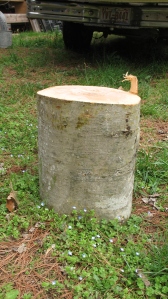
The bolt will yield two bowls. The first task is to split the bolt right through the heart center or pith.
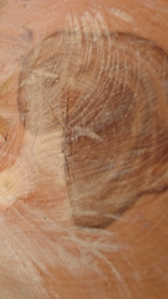
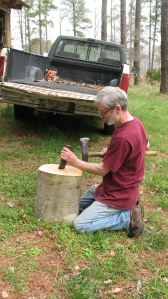
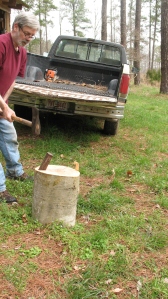
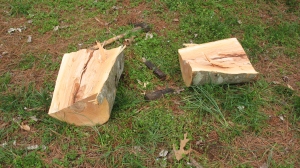
You’ll note that the blanks pictured are not equal in size. The bolt is split down the heart center or pith, which may or, as in this case, may not be the same as the geometric center. The pith is the dark line running down the face of each blank. Next the blank is sawn into a rough circle on the band saw.
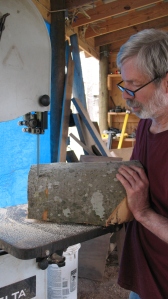 Then the round blank is mounted on a faceplate and fixed to the lathe.
Then the round blank is mounted on a faceplate and fixed to the lathe.

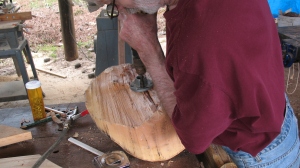
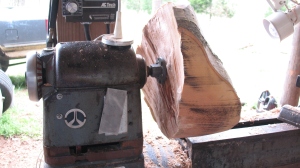


Now the turning begins. This piece is unbalanced so I start with the lathe barely turning. I gradually turn it up till the machine starts to shake, then back off until it stops. In the photos below it appears that the work is turning quite fast because the shavings are flying, but even with the lathe turning slowly a 14 inch disc is moving pretty fast at the circumference. The second photo shows that the gouge spends considerable time in the air. It’s out of the frame in these pictures, but at this stage I keep the butt of the tool handle in my leg or my side for better control.
Once it’s close to the shape I want on the outside of the blank I make a tenon for my chuck to hold. In this case I made a groove, a circular dado, I suppose, so that the chuck jaws can grip the tenon on the inside or be expanded to grip the outside of the dado. Now the bowl blank is removed from the faceplate and mounted in reverse on the chuck.
Now the bowl blank is removed from the faceplate and mounted in reverse on the chuck.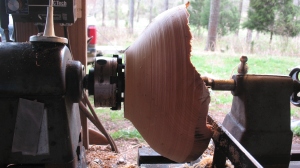
This piece is still a long way from being balanced, so the lathe is kept at a slow speed and, again, the tailstock is brought up for stability and safety. Facing off the blank will bring it substantially into balance.
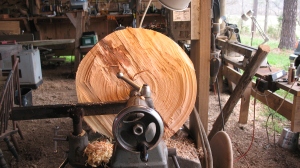 In this case, after facing off the top of the bowl blank I decided to re-true the outside so everything would be perfectly balanced. The chuck is supposed to be self-centering, but the tenon may not compress evenly or some other factor may introduce some wobble. This blank will be re-turned once it has dried, so it needn’t be perfect, but if it vibrates very much the inside turning will go much faster once the outside has been re-trued.
In this case, after facing off the top of the bowl blank I decided to re-true the outside so everything would be perfectly balanced. The chuck is supposed to be self-centering, but the tenon may not compress evenly or some other factor may introduce some wobble. This blank will be re-turned once it has dried, so it needn’t be perfect, but if it vibrates very much the inside turning will go much faster once the outside has been re-trued.
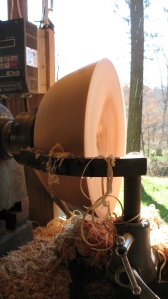
This wood is freshly cut: very green. You can see that once I’ve increased the speed of the lathe a bit the sap is flying from the bowl and dripping from the tool rest. I get a nice little shower as I true up the outside.
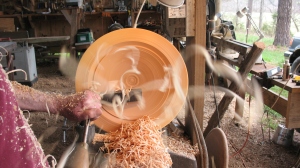 Now we can really make some beautiful curly shavings: balanced blank, green beech, tailstock pulled back out of the way, turn the lathe speed up to 5 or 600 rpm. Let’er rip!
Now we can really make some beautiful curly shavings: balanced blank, green beech, tailstock pulled back out of the way, turn the lathe speed up to 5 or 600 rpm. Let’er rip!

I want an even thickness in the walls and bottom so it will dry without cracking.


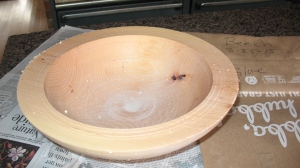
There are many ways to dry these bowls. In this case I painted the entire bowl with glue that had been thinned with an equal amount of water. I’ll put it in the heavy grocery bag that I’ve labeled with the date and type of wood and leave it for about 3 months before re-turning it.
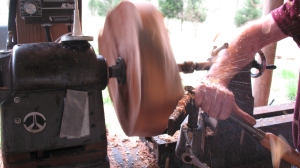

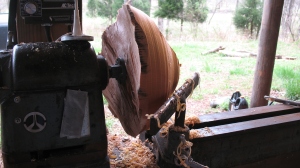
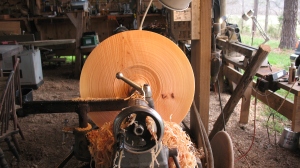
Fascinating stuff, Jim… I like the bowl turning !
LikeLike